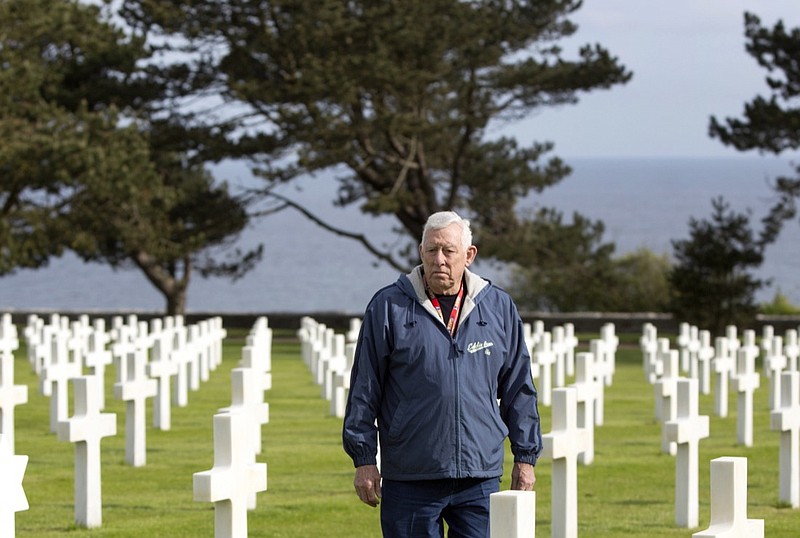Seventy-five years ago, on June 6, 1944, the Allied invasion of Western Europe began at Normandy on the northern coast of France. Code-named Operation Neptune, the day was quickly popularized as D-Day. Originally scheduled for June 5, the landings were delayed by bad weather. Weather forecasters predicted a lull in the storms for June 6. Postponement beyond that date would have necessitated at least a two-week delay to achieve favorable conditions for the landings. Seizing upon this information, Gen. Dwight Eisenhower, Supreme Commander of Allied forces, ordered Operation Neptune to proceed on the 6th.
Aerial bombardment of inland airfields, roads, bridges and fortifications began shortly after midnight. Thick clouds caused many bombs to miss their targets. Soon afterward, 24,000 American, British, and Canadian paratroopers landed with the goal of securing vital territory behind the beaches. Gliders brought both troops, jeeps and heavier armaments. Some paratroopers drowned as they landed in fields, which German forces had recently flooded. Wind, dense cloud cover and anti-aircraft fire led to many paratroopers being dropped far from their planned landing zones. Despite being scattered widely, small groups of airborne troops coalesced and created mayhem behind enemy lines.
A heavy Allied naval bombardment from 1,200 warships began at 5:45 a.m., targeting fortifications overlooking landing zones. Amphibious landings of soldiers began 45 minutes later at five landing zones. Thirty-two U.S. divisions landed at Utah and Omaha beaches. Twelve British divisions came ashore at Sword and Gold beaches. Three Canadian divisions landed at Juno beach. A French and a Polish division accompanied the invaders.
Wind and strong tides deflected some landing craft far from their assigned landing zones. Mines, obstacles, withering fire from shoreline defensive positions and artillery further inland threatened to trap some invading forces on the beaches. Courage, improvisation and persistence finally prevailed, and the beachheads were secured before day's end.
About 4,400 Allied soldiers, including 2,300 Americans, were killed. More than 6,000 were wounded. But by nightfall, 4,400 boats had unloaded 160,000 troops on the five beaches.
On June 12, forces from the five landing beaches finally linked and began a coordained drive inland. By June 30, 875,000 Allied troops had landed on Normandy's coast. Almost a year of fighting with heavy casualties would follow until Victory in Europe Day on May 8, 1945, when Germany surrendered unconditionally.
The first announcement of the D-Day Normandy landings reached the U.S. before dawn. Towns and cities responded in various ways. A single ring of the Liberty Bell was broadcast from Philadelphia. Radio networks carried sketchy updates along with statements from political leaders and patriotic music. I recall a prayer service in my community and relatives gathered around radios. D-Day stands most prominently in my memories of World War II.
Music provides a special way to commemorate D-Day. With the aid of YouTube, each of us can customize a concert to honor the bravery and sacrifice of the veterans of that day. I solicited nominations for a concert from friends, who know much more about music than I:
* Bob Bernhardt, music director emeritus and principal pops conductor, Chattanooga Symphony and Opera: John Williams, "Hymn to the Fallen" and "With Malice Toward None;" Edward Elgar, "Nimrod Variations."
* Nora Bernhardt, native plant gardener: Ennio Morricone, "Gabriel's Oboe."
* Kayoko Dan, music director, Chattanooga Symphony and Opera: Maurice Ravel, "Pavane for a Dead Princess," and Gabriel Fauré, "Suite aux Pelléas et Mélisade."
* Adrienne Harmon, violinist: Dimitri Shostakovitch, "4th Movement from 5th Symphony."
* Greisha Kuperstein, violinist, Baltimore Symphony: Gustav Mahler, "Adagietto from 5th Symphony."
* Janet Kuperstein, violinist: Camille Saint-Saens: "The Swan."
My nomination is Colm Wilkinson's rendition of "Bring Him Home" from the musical, "Les Miserables."
Share your musical nominations with me.
Contact Clif Cleaveland at ccleaveland@timesfreepress.com.

